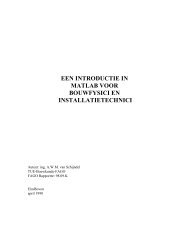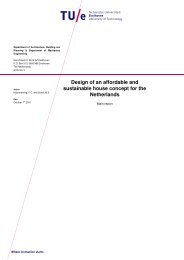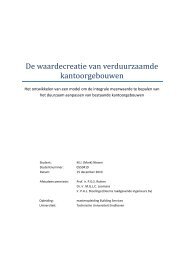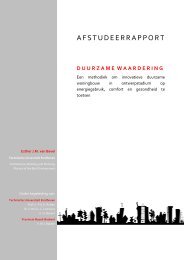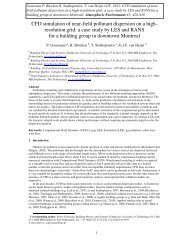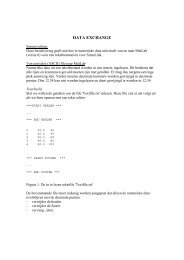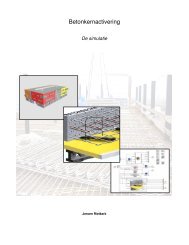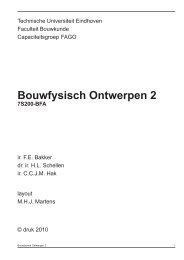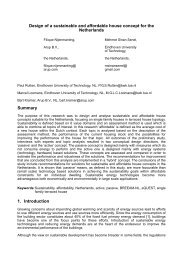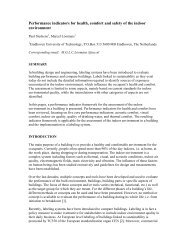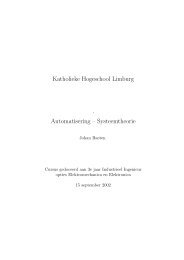First Year Assessment
First Year Assessment
First Year Assessment
- No tags were found...
Create successful ePaper yourself
Turn your PDF publications into a flip-book with our unique Google optimized e-Paper software.
MTOZ - Report <strong>First</strong> <strong>Year</strong> <strong>Assessment</strong> Radosevic, M_________________________________________________________________________Methodological aspectsThe research starts from existing and proven: building domain specific simulationenvironments, such as ESP-r and TRNSYS, and from domain independent simulation software,such as MATLAB/Simulink. The work focuses on the external coupling. The term externalcoupling is used to highlight the fact that two or more different simulation packages are used, asadverse to internal coupling where all calculations are within one simulation environment.Although the current work starts with run-time coupling of particular simulation environments,the coupling mechanism and data-exchange protocol that will be developed will ensure that theapproach has a wide and general applicability.SYSTEM SIMULATIONSOFTWAREBUILDING ENERGYSIMULATION SOFTWAREREAL BUILDING AND/ORSYSTEMFigure 1 External couplingThe cooperation of chosen starting environments is being developed using software rapidprototyping. The definition of a rapid prototype is overtaken from similar ongoing researchproject at TU/e [19], [20] and means working model that is developed from existing software tohighlight a specific function with a minimum amount of effort. That is based on the fact that asfar as program has a time-step based mechanism of importing/exporting simulation results, it canbe coupled.The simulation environments are made to co-operate using Unix scripts and/or somesmall programs, and code modifications for added functionality where appropriate and/orpossible. Using an intermediate data exchange facilities it can be allowed that coupled programsrun in parallel on separate computers.The co-operative building and system simulation environment will be verified using oneor more of the known validation techniques: comparison with physical experiments performedunder controlled laboratory conditions, comparison with analytical solution or comparison withresults from other programs or different already validated coupling approaches. If needed,additional tests will be performed in an experimental set-up and in a real scale experimentalbuilding at TU/e. Besides, the relevance of the approach needs to be tested. The utilitarianverification will be based on the application of at least two real design studies. A potentialapplication case has been recognized in Vertigo building at the site of TU/e. The building isconnected to the underground heat and cold storage. Due to its dynamic nature, the systemsimulation, can be accurately carried out only by coupling of simulation environments.Associated with this will be the generation of guidelines regarding the necessity/applicability of building and system simulation and the co-operative approach in terms ofintegrated design of buildings and systems.The main focus is on:- Definition of minimum necessary number and type of information/data that has to beexchanged between applications in run-time in order to ensure the consistency of results.- Determination of frequency of specific data exchange5
MTOZ - Report <strong>First</strong> <strong>Year</strong> <strong>Assessment</strong> Radosevic, M_________________________________________________________________________Summary of the first year workUp-to-date progressDuring the first months the work focused on literature review and familiarization withsoftware. I finished couple of courses: ESP-r; TRNSYS – course in Liege as well as Matlab andC course (detailed list is given below). Some additional experience was gained from beingexposed in co-teaching simulation to third year students. I helped in changing the content of thecourse 7S410 - Introduction to building performance simulation for integrated solutions, whichmade me familiar with different building simulation software available today. As the newsoftware, ECOTECT, was introduced to the class, the need to evaluate its quality assurance wasrecognized. To achieve this, BEStest procedure was used. Working with BEStest familiarized mewith inter-model comparison, validation technique. This knowledge will be of use in the laterstage of the research (the developed prototypes can be validated with expanded version of themethod BESTEST-HVAC as reported in [21]). This work has resulted into an article that issubmitted to PLEA conference [22]. Additionally, I introduced the professors / lecturers withpossibilities and limitations of the software in the seminar: Planned Changes in the Curriculum& Quality Aspects of Ecotect organized at Bouwkunde.Besides papers (listed in Education program), two reports came out as the result of thelast year. The first report (03.73) is an overview of ECOTECT that summarizes the experience ofworking with the software and gives a critical point of view of some software features. Thesecond (03.74) came out as the result of investigation of HVAC system (together withunderground heat storage) in Vertigo building. This was done to later facilitate the plannedapplication study, as mentioned previously.Initial prototypeThe main outcome of the first year is the early prototype cooperative building and airsystem design environment. After starting familiarization with UNIX and ESP-r, I continued toexamine the source code of the program itself. To enable coupling, a part of the code waschanged and the new air component was developed. To test the prototype the low energy housingin Korea from literature [23] was used (Fig. 2). It includes an underground earth-to-air heatexchanger that preheats ventilation air in the winter or precools it in the summer. The buildingincorporates a double-skin south facade, which can act as a solar collector for additional heatingof ventilation air, coming from the ground coupled exchanger, during the heating season, whilein the summer it is bypassed to avoid overheating of the air. In the summer, double skin facade isnaturally ventilated. Due to the transient solar behavior and the dynamic nature of theunderground heat storage the double skin façade and the ground-coupled heat exchanger willaffect the building heating and cooling load in a very dynamic way. It is only an integratedapproach that can allow the prediction and assessment of the effects of the double skin and theground heat exchanger on the overall system performance.6
MTOZ - Report <strong>First</strong> <strong>Year</strong> <strong>Assessment</strong> Radosevic, M_________________________________________________________________________keep the dynamic evaluation of the results, the necessary information is externalized. Toinitialize the external (history) data some preprocessing, meaning performance of the precalculationwith the external program is needed. The transfer of the history data betweendifferent time steps can be seen as an artificial continuous program-run.The first steps towards an early abstraction of the prototype are now under consideration.The model of the aquifer written in MATLAB will be the program to couple with ESP-r in thenext stage. As an aquifer is the water component there was a need to generate another, watercomponent, as addition to the previously explained air component. Both components functionidentically. The work is still in progress.In the future, the prototype will be dynamically improved, by coupling differentsimulation environments. The coupling mechanism and the data-exchange protocol will beobtained from maturing the prototype. The generalization of the initial prototype will ensure thatthe approach has wide and general applicability. The general knowledge will be extracted fromthe wide range of specific problems solving.Demonstration resultsThe model of the heat exchanger in EARTH requires several parameters, such as: meanannual temperature of the soil surface, amplitude of annual surface temperature variation, somesoil physical properties (thermal conductivity, density, humidity, specific heat). As most of thementioned parameters are dependent on the specific climate and vary from region to region, theinformation is lacking and is difficult to be obtained from the literature. The recommendationsfor: air velocity / pipe dimensions, and some soil physical properties are taken from: [24], [25]and [26]. It has to be mentioned that values of these parameters can influence the results and thatthe sensitivity analysis has not been done yet.The demonstration case involves comparison of energy saving potential of several designoptions of earth-to-air heat exchanger coupled to the double skin façade. The simulation isperformed for Korea climate and a period of one winter week. Additionally, the results arecompared to those obtained from the approach used in [23].Case number 1 assumes the length of heat exchanger of 100m at the depth of 2,5m. Toinvestigate how different design options could influence the energy saving potential, cases 2 and3 assumed quite different lengths (30m and 250m) and depths (1m and 6m) of the exchangercompared to the first case. The gross heat gain by both the ground coupled heat exchanger andthe double skin is evaluated from the difference between the ambient temperature and thetemperature at the upper part of the double skin. It was assumed that system operates between8a.m and 19p.m. In some hours the heat gain is higher then the overall loss of the building itself.That is why the minimum of these two values for the each point of time is used to assess theenergy saving potential. The results are shown on the figure 4.8
MTOZ - Report <strong>First</strong> <strong>Year</strong> <strong>Assessment</strong> Radosevic, M_________________________________________________________________________[20] A. Yahiaoui, J. L. M. Hensen and L. Soethout. Integration of control and building performance simulationsoftware by run-time coupling. Proc. 8th International IBPSA Conference Building Simulation, 1435-1442.2003. International Building Performance Simulation Association. 2003.[21] J. Neymark, R. Judkoff, G. Knabe, H.-T. Le, M. Durig, A. Glass and G. Zweifel. HVAC BESTEST: Aprocedure for testing the ability of whole-building energy simulation programs to model space conditioningequipment. 7th International IBPSA Conference, 369-376. 2001. Brazil, International Building PerformanceSimulation Association.[22] M. Radosevic and J. L. M. Hensen. Teaching building performance simulation - some quality assuranceissues and experiences. 2004. Plea 2004.[23] Jong H.Yoon, Euy J.Lee, and J. L. M. Hensen, "Integrated thermal analysis of a three story experimentalbuilding with a double skin facade and a ground coupled heat exchanger," Proceedings of International SolarEnergy Conference SOLAR 97, 1997.[24] J. Pfafferott, "Evaluation of earth-to-air heat exchangers with a standardised method to calculate energyefficiency," Energy and Buildings, vol. 35, no. 10, pp. 971-983, Nov. 2003.[25] G. Mihalakakou, J. O. Lewis, and M. Santamouris, "The influence of different ground covers on the heatingpotential of earth-to-air heat exchangers," Renewable Energy, vol. 7, no. 1, pp. 33-46, Jan. 1996.[26] G. Mihalakakou, "On the heating potential of a single buried pipe using deterministic and intelligenttechniques," Renewable Energy, vol. 28, no. 6, pp. 917-927, May 2003.12




